Urban gardens: Hipster movement or resilience strategy?
Nowadays we cannot overlook all the web images about urban gardens, productive gardens, green roofs, etc. Similarly, there is a huge amount of restaurants, shops and supermarkets that are introducing concepts like “home grown”, “organic” and “fresh”.
Therefore the notion of the urban gardens has arisen as a recent trend particularly followed by hipsters 1 or high-income people. Nevertheless, it is important to remember that beyond this recent trend, the small scale productive gardens have been a resilience 2 estrategy for mankind.
Almost every agricultural society of the past, such as the Egyptians, the Mesopotamians, the Mesoamerican civilizations, among many others, used small domestic-scale cultivation methods that supplied enough food for most of the families.
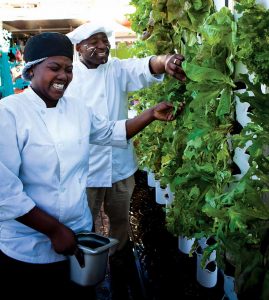
The aquaponic cultivation system integrates processes of hydroponic cultivation and aquaculture (fish farming). This process does not require a substrate as it reuses pond water as a nutrient solution for the plants.
Photography: Jan Ras
https://www.visi.co.za/farming-the-va/
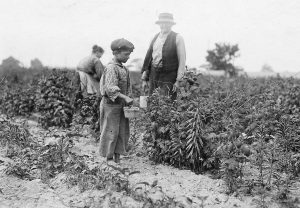
The cultivation of vegetables was a relief for the migrants’ demand for food at the beginning of the XX century.
Johnnie Yellow, a little farmer of Polish origin at Bottomley Farm Farm, Maryland, 1909.
Photography: Louis Wickes Hines, Archivos Nacionales de Estados Unidos. United States National Files 102-LH-834 (Flickr
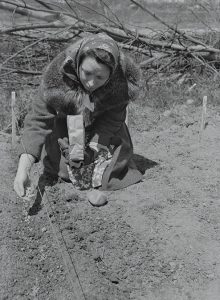
Woman planting peas in a Victory Garden.
Fairlawn Avenue, Washington, D.C.,1943.
Photography: Library of Congress.
http://modernfarmer.com/2014/01/15-victory-garden-pics/
Despite the accelerated growth of cities, urban gardens have not disappeared but continue to exist in specific contexts.
One of the most emblematic examples of the twentieth century in the West is the “Victory Gardens” in the United Kingdom and United States during the First and Second World War. These urban gardens where developed in conventional gardens to produce food, because the conventional methods were diminished at the time.
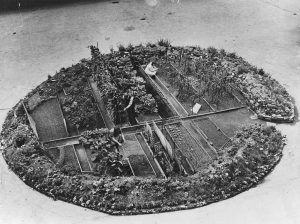
Aerial view of an orchard made in the crater
of a bomb in London in 1943.
Photography: NARA record: 1138532, By Office
of War Information. (1942 – 1945)- U.S. National Archives and Records Administration, https://commons.wikimedia.org/w/index.php?curid=16573550
In the United States this campaign was promoted by the National War Garden Commission in 1917 4 especially for the women, who were an extremely important force of labor during these periods.
The name “Victory Gardens” derives from the publicity campaign phrases such as “Sow the Seeds of Victory”, “Dig for Victory, Grow your own Vegetables”, “Plant a Garden for Victory”, “A garden will make your rations go further”, “Our Food is Fighting”.
Also in France many women started replacing men in the agricultural work, in the same way soldiers, prisoners and students begun to occupy areas in the outskirts of Paris to grow food 4.
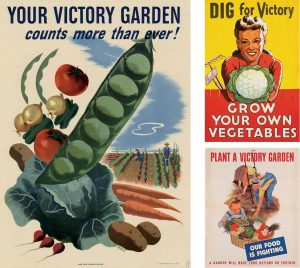
Second World War propaganda encouraged the cultivation of orchards as a defense strategy.
/ Illustrations: Wikicommons, Boston Public Library (Flickr)
These First World War efforts were especially important because they served to educate a large quantity of people about horticulture and agriculture, also teaching them the most important food production techniques.
Later on, during the Second World War these resistance strategies where put into practice and agriculture emerged once more in every city corner: drawers, roofs, sidewalks, buckets, etc.
Nowadays we regard these Victory Gardens as a paradigmatic example of social organization, education, generation of new alimentation strategies, and resilience during and after war. Many people today are supporting the cause of Food Sovereignty 5, whether the live in megalopolis or small towns, and they are proposing new strategies of urban agriculture.
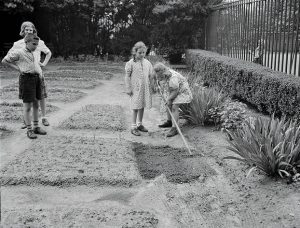
Children working at their school in a Victory Garden on First Avenue between 35th and 36th Streets, New York, 1944. Photography: Library of Congress. http://modernfarmer.com/2014/01/15-victory-garden-pics/

Nowadays in Haiti urban orchards constitute a resilience strategy in the face of natural disasters and scarce resources.
Photography: https://markjacobs.co/2014/09/23/urban-gardening-cite-soleil-haiti/ y Alexander Joe AFP, Borden magazine, http://www.borgenmagazine.com/usaid-carbon-roots-improve-haitian-agriculture/
Fortunately in Mexico the agriculture is practiced on many areas that are close to the cities. Plus, initiatives such as Huerto Romita 8 or Colectivo Milpa 9, among others, are generating important spaces for knowledge, reflection and urban agriculture development.
Despite many companies and business seek to take advantage of this movement for selling fashionable products, many experts 10 consider that the gardens, particularly in cities are a solution to food crisis, climate change and poverty, all of them big challenges of the twenty-first century.
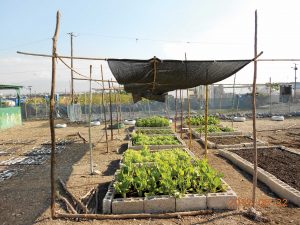
Full article in our 03 printed edition.
REFERENCES
1 According with the Oxford Dictionary, a person who follows the latest trends and fashions, especially those regarded as being outside the cultural mainstream.
2 According to the Royal Academy of Spanish Language, a living being’s adaptative ability to face a disturbing agent or an adverse state or situation.
3 Food and Agriculture Organization of the United Nations, “Food into Cities” Collection, DT/43-00E, Rome, (2000).
4 Ana Duarte Rodriguez, The Small Power of ‘Small’ Gardeners during the Great War en Uma Pequena Potência é uma Potência? (Lisboa: Cadernos Instituto da Defesa Nacional, 2015).
5 Food Sovereignty is the right of peoples, communities, and countries to define their own agricultural, labor, fishing, food and land policies which are ecologically, socially, economically and culturally appropriate to their unique circumstances. Political Declaration of the NGO / CSO Forum for Food Sovereignty. Rome, June 2002.
6 Conferencia impartida en la plataforma TED.com en 2012 “Cómo podemos comer nuestros paisajes”. Sobre los huertos urbanos en Todmorden, Reino Unido.
7 Película documental de Mélanie de Laurent y Cyril Dion “Mañana” (Demain) estrenada en 2016 en Francia.
8 Agricultura Urbana en la Ciudad de México. http://www.huertoromita.com/
9 Agricultura Urbana en Mérida, Yucatán. https://www.facebook.com/colectivomilpa/
10 Especialmente para la FAO (Food and Agriculture Organization of the United Nations).








